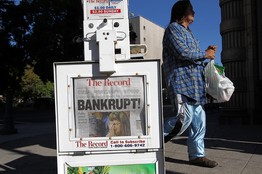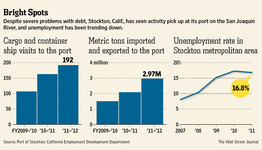By MAX TAVES And BOBBY WHITE
STOCKTON, Calif.—City officials here failed to strike a deal with creditors to keep it from becoming the largest U.S. city to file for bankruptcy protection, as the lingering burden of the housing bust and soaring pension obligations overwhelmed an otherwise improving local economy.
Stockton, a Northern California city in the agriculture-heavy San Joaquin Valley, is set to formally file a petition under Chapter 9 of the U.S. Bankruptcy Code in the next few days after mediation with creditors ended with no resolution.
At a City Council meeting late Tuesday, council members voted 6-to-1 in favor of a new budget that allows the city to pay for day-to-day operations while in bankruptcy proceedings. The scene at the meeting was raucous, as a crowd of mostly retired city workers bemoaned the likely hit to their medical benefits. Some quoted Bible passages, and a member of the audience was ejected for being disruptive.
Council members said Chapter 9 was the only choice. Paul Canepa, a council member who voted for the budget, said, "With a heavy heart, I will be supporting this.…I'm very sorry for this decision, but I have to do this."
Marc Levinson, the city's bankruptcy attorney, said there is "no chance that the city would be able to cut a deal with its creditors that would enable it to avert insolvency on Sunday," when the new budget goes into effect.
Stockton, with about 300,000 residents and a $700 million debt load, is set to become the largest U.S. city ever to seek Chapter 9 protection, bankruptcy officials said. Chapter 9 shields a financially distressed municipality from creditors while it develops a plan for adjusting its debts, barring them from demanding a liquidation of assets to pay off obligations.
Bridgeport, Conn., which has 141,000 residents and filed for Chapter 9 in 1991, is to date the largest city by population to enter bankruptcy, according to federal records. And until now, the city with the biggest debt load entering bankruptcy was Vallejo, Calif., which owed $50 million to creditors when it filed in 2008. (Vallejo emerged from insolvency last year.)
Several municipalities nationwide have had to file for bankruptcy protection in recent years, including Central Falls, R.I., and Jefferson County, Ala., and more are on the brink. In California, the cities of Hercules and Lincoln are attempting to restructure their debts and cut employee costs to forestall insolvency. Other U.S. cities that may consider bankruptcy include Detroit and Harrisburg, Pa., debt analysts say. The state successfully challenged an attempt by Harrisburg to file for bankruptcy protection in 2011.
Late last year, Hercules retained bankruptcy attorneys in part to explore options with its creditors."Cities are facing significant pressure from the housing downturn and retiree costs," said Karol Denniston, a municipal finance lawyer who helped draft California's city bankruptcy law. "Many are clinging to solvency. We will see more Stocktons."
Stockton's slide into bankruptcy comes even as its economy shows improvement. The Stockton area leads all 27 metros areas in California in terms of job gains from March 2011 to March 2012, according to the state Employment Development Department, fueled by construction of a hospital for state prisoners, strong exports at the Port of Stockton, on a channel linked to the San Joaquin River, and a pickup in the area's farm economy.
The city's unemployment rate is still high but down sharply, falling 1.8 percentage points to 17.5% last month from a year earlier.
Yet the nascent gains aren't enough to rescue Stockton's municipal budget, which has weathered plunging property-tax revenues from the housing crisis and high costs from pensions and other factors.
Stockton's road to insolvency began in 2007, when the housing crisis began to erode property values, hurting property-tax revenue. Median home prices here have fallen from their 2005 peak of $407,000 to $118,000 as of February, according to local officials.At the same time, Stockton needed to pay out pensions and health-care costs for its retirees and was working on an expensive downtown-revitalization effort. According to a city report issued in May, retiree health costs and pension costs are expected to soar 115% and 94%, respectively, by 2022.
All of that caused a budget deficit and led Stockton to take on debt. To close the gap, Stockton slashed more than $90 million from its budget since 2009—including reducing its police department by 25%, cutting its fire department by 30% and slashing pay by as much as 22% for some workers. It also defaulted on three sets of bonds, causing it to lose control of three parking garages and an eight-story office building that was supposed to be its new city hall. Despite the budget cuts, Stockton faced a $26 million budget deficit for the fiscal year beginning this coming Sunday, July 1. The deficit is expected to grow to $40 million annually by 2016, according to city records.
Since 2010, Stockton has also declared two fiscal emergencies. In 2010, the city restructured contracts for police and fire, resulting in lawsuits from the police and fire unions, some of which are still pending.
In February, Stockton entered into negotiations with creditors as mandated by a new state law requiring municipalities to engage in mediation before declaring bankruptcy. But on Tuesday, Stockton officials said the talks resulted in agreements with only about a third of the 19 creditors that participated in negotiations.
Some city officials said they are optimistic that Stockton's improving economy will augur for a better foundation for the town. Stockton's Interim Chief Financial Officer David Millican said some tax revenues—namely sales tax and utility users tax—show signs of rebound. Stockton "has all the assets it has always had. It has a port, a university [and] it's an important agricultural center," Mr. Millican said. "Stockton is not Detroit."
—Michael Corkerycontributed to this article.
Write to Bobby White at bobby.white@wsj.com
A version of this article appeared June 28, 2012, on page A3 in the U.S. edition of The Wall Street Journal, with the headline: On the Mend, but Going Bust.


![[image]](https://iza-server.uibk.ac.at/pywb/dilimag/20210113092156im_/http://si.wsj.net/public/resources/images/OB-TN743_0627st_F_20120627085504.jpg) Associated Press
Associated Press





![[image]](https://iza-server.uibk.ac.at/pywb/dilimag/20210113092156im_/http://si.wsj.net/public/resources/images/OB-TP243_wynn07_A_20120702000014.jpg)
![[image]](https://iza-server.uibk.ac.at/pywb/dilimag/20210113092156im_/http://si.wsj.net/public/resources/images/MK-BV389_HOUGHT_C_20120701170025.jpg)
![[image]](https://iza-server.uibk.ac.at/pywb/dilimag/20210113092156im_/http://si.wsj.net/public/resources/images/MI-BP829_curry_C_20120701170605.jpg)
![[image]](https://iza-server.uibk.ac.at/pywb/dilimag/20210113092156im_/http://si.wsj.net/public/resources/images/NY-BT061_SWIM_C_20120701193212.jpg)
![[image]](https://iza-server.uibk.ac.at/pywb/dilimag/20210113092156im_/http://si.wsj.net/public/resources/images/P1-BG850_SCYTHE_C_20120629173254.jpg)
![[image]](https://iza-server.uibk.ac.at/pywb/dilimag/20210113092156im_/http://si.wsj.net/public/resources/images/OB-TO602_boxila_C_20120628203443.jpg)






Most Recommended
“Try and fathom the hypocrisy of ...;”
“Perhaps, Mr Gensert, it's not th...;”
“Another thoughtful and concise...;”
“However, Ms Napolitano immediate...;”
“My thought, exactly...You go on...;”